

29065832004focusoninquiry. How Integrating Arts Into Other Subjects Makes Learning Come Alive. Art has long been recognized as an important part of a well-rounded education — but when it comes down to setting budget priorities, the arts rarely rise to the top. Many public schools saw their visual, performing and musical arts programs cut completely during the last recession, despite the many studies showing that exposure to the arts can help with academics too. A few schools are taking the research to heart, weaving the arts into everything they do and finding that the approach not only boosts academic achievement but also promotes creativity, self-confidence and school pride.
The arts integration experiment at Integrated Arts Academy at H.O. Wheeler (IAA) in Burlington, Vermont, started six years ago as an effort to break up socioeconomic imbalances in the district. What does art integration look like? “Higher analytical thinking and reasoning and student voice fit so well with the arts,” said Bobby Riley, the school’s principal. The school is seeing results from the experiment. 10 Tips For Launching An Inquiry-Based Classroom. Transforming teaching practices is a long, slow road.
But increasingly schools and teachers experiencing success are sharing their ideas online and in-person. Science Leadership Academy opened as a public magnet school almost ten years ago in Philadelphia. The educators that make up the school community have spent nearly half that time sharing best practices through a school-run conference each year and more recently by opening a second school in Philadelphia. Diana Laufenberg was one of the first SLA teachers and has gone on to help foster inquiry at schools around the country, most recently by starting the non-profit Inquiry Schools.
24 Questions to Enhance Students Reflective and Critical Thinking Skills. August 31, 2014 Reflection is a fundamental skill from which is branched out all other thinking skills.
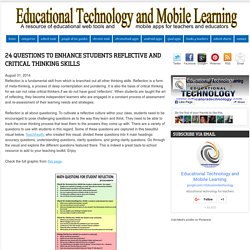
Stop, Start, Continue: Conceptual Understanding Meets Applied Problem Solving. I recently became the Chief Academic Officer for the International Baccalaureate (IB) after more than two decades of working in and leading IB schools.

In IB World Schools, we endeavor to create internationally-minded young people who, recognizing our common humanity and shared guardianship of the planet, help make a better and more peaceful world. Just prior to taking this position, I led the intense experiential living and learning of a United World College (UWC). I was part of an intimate and remotely-located community of 160 students who lived on the Vancouver Island site, along with faculty and their families, for two intensive pre-university years of transformational learning. Together, we pursued the UWC mission of making education a force to unite people, nations, and cultures for a sustainable future. Every year we built a community that modeled what all of us wished for in the wider world. Inquiry-Based Learning: From Teacher-Guided to Student-Driven. Student: I opened it up, and there was a root inside.
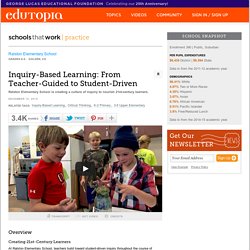
Anne: What's exciting about the inquiry models that we go far and above what the curriculum expectations are. TTS Universal™ – The 4Es [+1] of TTS 4Es. How To Use Twitter For Exit-Slip Teaching - 8 Reflective Questions To Help Any Student Think About Their Learning by TeachThought Staff For in-person professional development from TeachThought on reflection in learning or any other topic your school or district might need, contact us today.
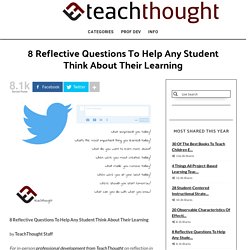
What’s the big deal about thinking about something that already happened? Does your classroom make learning visible? – EDUWELLS. I had a fantastic planning day with the leaders in my school yesterday where we evaluated how conscious and engaged our students were in their own learning.

The consensus was that our overall system was still very teacher driven and much work had to be done to encourage teachers to involve the students in, and make them more aware of the process of learning they were experiencing. Why IS a Math test like a clay elephant? I had a brief conversation with a 12 year old boy this month that went as follows: Teacher: “What’s your favourite subject?” Student: “Art”Teacher: “What are you doing in Art?” Unless teachers make the reason for and the progress in learning something permanently visible to the learners, the tasks and activities just become “more work.” When Kids Have Structure for Thinking, Better Learning Emerges.
Amidst the discussions about content standards, curriculum and teaching strategies, it’s easy to lose sight of the big goals behind education, like giving students tools to deepen their quantitative and qualitative understanding of the world.
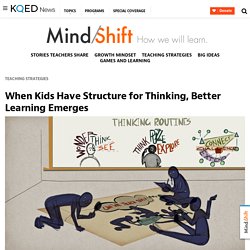
Teaching for understanding has always been a challenge, which is why Harvard’s Project Zero has been trying to figure out how great teachers do it. Some teachers discuss metacognition with students, but they often simplify the concept by describing only one of its parts — thinking about thinking. Teachers are trying to get students to slow down and take note of how and why they are thinking and to see thinking as an action they are taking. But two other core components of metacognition often get left out of these discussions — monitoring thinking and directing thinking. When a student is reading and stops to realize he’s not really understanding the meaning behind the words, that’s monitoring. A Handy Visual Featuring 6 Essential Skills for Doing Online Research. Reflective Learning: What It Is And Why It Matters. How do you learn?
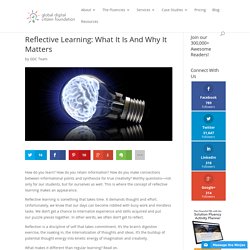
How do you retain information? How do you make connections between informational points and synthesize for true creativity? Worthy questions—not only for our students, but for ourselves as well. This is where the concept of reflective learning makes an appearance. Reflective learning is something that takes time. The Difference Between Search And Inquiry. The Difference Between Search And Inquiry by Terry Heick Ed note: This post is part 2 of 2 in a mini-series on Google and student inquiry.

Part 1 can be seen here. As we recently talked about, Google impacts thinking by putting a universe of information at the end of any internet connection. This is both true and unhelpful. A fact. A connection. A literacy strategy. A model. Critical Thinking Explained for Students. May 1, 2016 Critical thinking is an essential skill for the 21st century students.
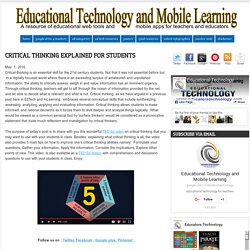
Not that it was not essential before but in a digitally focused world where there is an exceeding surplus of amateurish and unpolished information, the ability to critically assess, weigh in and value information has an imminent urgency. Through critical thinking, learners will get to sift through the ocean of information provided by the net and be able to decide what is relevant and what is not. Critical thinking, as we have argued in a previous post here in EdTech and mLearning, ‘embraces several conceptual skills that include synthesizing, assessing, analyzing, applying and evaluating information.
Critical thinking allows students to make informed and rational decisions as it forces them to dive deeper and analyze things logically. The purpose of today’s post is to share with you this wonderful TED Ed video on critical thinking that you may want to use with your students in class. Helping Your Students Learn To Reflect On Their Learning - Today, we finished the second week of an interpersonal communications course.
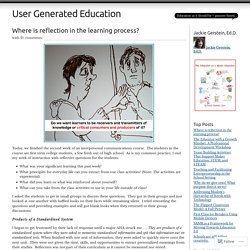
The students in the course are first term college students, a few fresh out of high school. As is my common practice, I end my week of instruction with reflective questions for the students: 5 Characteristics Of Project-Based Learning That Works - Schedule a TeachThought Professional Development PBL Workshop For Your School > 5 Characteristics Of Project-Based Learning That Works by Drew Perkins, Director of TeachThought Professional Development Interested in learning more about how to leverage great thinking and learning using authentic project-based learning?
Check our PBL Workshop Services. What is Inquiry? Why Inquiry? Inquiry learning process. Socratic Questioning. Techniques > Questioning > Socratic Questions Conceptual | Assumptions | Rationale | Viewpoint | Implications | Question | See also Socrates was one of the greatest educators who taught by asking questions and thus drawing out answers from his pupils ('ex duco', means to 'lead out', which is the root of 'education').
Sadly, he martyred himself by drinking hemlock rather than compromise his principles. Bold, but not a good survival strategy. But then he lived very frugally and was known for his eccentricity. Here are the six types of questions that Socrates asked his pupils. Inquiry learning process. Active Learning - Geoff PettyGeoff Petty. We learn by doing. Promoting Active Learning. Leading and learning: Educational Readings - student centred inquiry learning and the importance of making things.
By Allan Alach. 3 Simple Strategies to Develop Students’ Critical Thinking – Education to Save the World. This week we’ve focused on critical thinking using the model developed by the Foundation for Critical Thinking. By now you’re probably excited about the incredible potential that these tools hold…and a little overwhelmed. 6 tips for making the most of PBL. 10 Tips For Launching An Inquiry-Based Classroom.
An Inquiry Framework: Levels Of Student Ownership. (Image removed; new image forthcoming) Student Power! The key commodity in education has been knowledge. It's the reason why we built buildings called schools and required children to come from miles around to sit in a room with the knowledge held in teachers' brains and captured between the covers of textbooks. That model has clearly been disrupted or -- to be honest -- destroyed. 50 Questions To Promote Metacognition In Students. 7 Great Educational Web Tools That Encourage Inquiry-based Research.
8 Steps To Design Problem-Based Learning In Your Classroom. 10 Tips for Teaching Kids to Be Critical Thinkers. Put a new spin on bell ringers by asking a Question of the Day. Use a questioning stem (e.g., “Create a riddle that uses the mathematics term ‘multiply’ in one of the clues” or “Write a letter to a classmate recommending this book”) and put it on the board.
3 Ways to Teach Everything Through Inquiry. The 4 Cs of Learning. How to Reinvent Project Based Learning to Be More Meaningful. Inquiry-Based Learning: The Power of Asking the Right Questions. Teaching Students How to Take Notes – Moving From Mechanical to Effective. Reinventing School From the Ground Up For Inquiry Learning. Wonder Ground. The case for project-based learning.